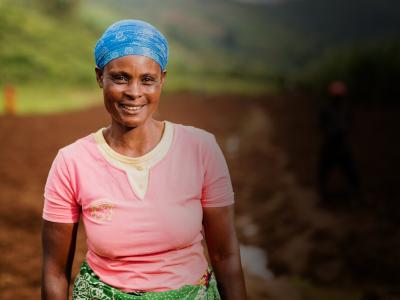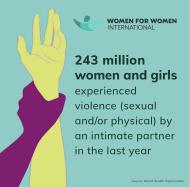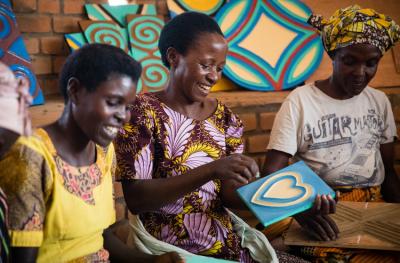I’m Hanna Nussair, a current Master of Human Rights student at the University of Minnesota concentrating in the rights of women and girls. My graduate research focuses on gender empowerment, educational equity, and eliminating violence against women. While working on my masters, I am a consultant for Women for Women International’s communications team.
According to the World Health Organization (WHO), 1 in 3 women face some form of sexual, physical or psychological violence in their lifetime (1). This number cannot even begin to describe the impacts of violence against women on individual communities and marginalized populations, particularly in the world’s conflict zones.
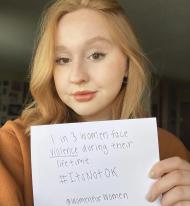
The global culture of violence against women is carried out in many ways across conflict zones. Devastating projections for specific groups of women indicate women who live in conflict zones are 50% more likely to experience violence than those who do not (2).
“It has probably become more dangerous to be a woman than a soldier in armed conflict.” says Major-General Patrick Cammaert, former commander of United Nations peacekeeping forces in the eastern Congo.
Sexual violence in conflict zones systemically targets mothers, sisters, and daughters. In my master’s research, I study three types of gender based violence that continue to perpetuate cycles of trauma for women and girls in conflict zones across generations.
Today as part of our 16 Days of Activism to End Violence against Women, learn about these forms of sexual violence against women.
1. Female genital mutilation: The Kurdistan Region of Iraq
Worldwide, it is estimated that up to 140 million women have experienced female genital mutilation (FGM) (3). Extensive efforts have tried to combat the practice over the last few decades, specifically in the Kurdistan region of Iraq where current reports show 42% of women undergo the procedure (4). Highly populated areas such as Erbil City have reported numbers as high as 60% (5).
The WHO defines the practice as the removal of the female genitalia, either partially or fully, for non-medical reasons (6). The practice is commonly performed without the full consent of the woman or girl, making it a violation of her human rights. The practice can result in long-lasting physical and psychological trauma including severe pain, infections, childbirth complications, and sometimes, death (7).
While the practice is outlawed by the Kurdistan Regional Government, studies show that the law is often not enforced (8).
In the region, this practice is cultural and passed down through a family line encouraged by a mother or woman relative in a girl’s life. Mothers often choose to have their daughters undergo FGM because they believe their daughter will not find a husband unless she is “cut”. However, only 1 in 3 women and girls are ever told the dire health risks of the practice (9), and most girls receive the procedure at 4 to 5 years old (10) . The costs of FGM are not only a catastrophic abuse to human rights to individual women, but it imposes a crippling economic cost to treat long-term health conditions according to WHO (11).
This is not okay.
2. Rape as a Weapon of War: The Democratic Republic of the Congo
When conflict erupts, rape is a common tactic used to destroy the lives of women and their families in war. The traumatic method is designed to manipulate gender norms, humiliate survivors, and spread fear among entire communities. Perpetrators can be anyone — military officers, militants, civilians, or workers in displacement camps (12).
According to recent reports in the United States, nearly 50 women are raped in the Democratic Republic of Congo (DRC) each hour (13). A similar report found that 68% of survivors are children (14).
Many of those affected are forcibly displaced people, and the horrific act happens as women and children are fleeing their homes (15).
The lack of medical infrastructure in rural areas of the DRC make the health effects of rape even more life threatening. Many women experience permanent damage on their bodies and may be shunned from their communities (16). They may face HIV/AIDs, unwanted pregnancy, and post-traumatic stress disorder.
In many cases, survivors of rape never report due to a culture of severe victim blaming, and lack of trust in receiving any form of justice.
This is not okay.
3. Child Marriage: South Sudan
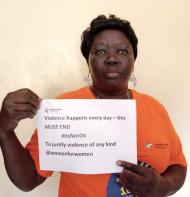
According to UNICEF, 52% of girls will be married before the age of 18 years old in South Sudan (17) — which is one of the highest rates of child marriage in the world today.
Financial instability brought on by COVID-19 has exacerbated this problem; families in poverty are taking their daughters out of school at higher rates and arranging their marriages to save money (18).
When girls are sold into their marriage, they face heightened risk of intimate partner violence, such as physical abuse and rape (19). Forced marriage often leads to early pregnancy, and currently 1 in 3 girls in South Sudan become pregnant before the age of 15 years old (20). These pregnancies can be life threatening for both the mother and the child, young mothers face serious health complications on their bodies before their body is ready to carry children. This is one of the reasons that South Sudan also has one of the highest maternal mortality rates in the world (21).
While the constitution of South Sudan declares that no marriage should take place without free and willing consent, this law is often not enforced due to gender norms (22).
On December 2, 2021, the government of South Sudan declared it will end child marriage by 2030 in line with the African Union, and we await firm implementations of measures to stand by this promise (23). But South Sudan is not the only place where children are forced to marry. Across the world, millions of girls are sold into marriage, resulting in early pregnancy, social isolation, and further violence, and more.
This is not okay.
While the issue of violence against women is overwhelming, we cannot give up on women and girls in conflict zones vulnerable to these forms of violence and many others. Join me and Women for Women International this 16 Days of Activism. Stand with us to say #ItsNotOK.
Footnotes:
2. Women for Women International UK, "Why Women in Conflict?" (2021)
4. 28 Too Many, "FGM in Iraqi: Short Report" (2020)
5. U.S. Department of Justice, "Iraq: Female Genital Mutilation" (2020)
6. World Health Organization, "Female Genital Mutilation" (2020)
7. George Washington University, "What are the mental health effects of FGM?" (n.d.)
8. Human Rights Watch, "Iraqi Kurdistan: Law Banning FGM Not Being Enforced" (n.d.)
11. World Health Organization, "Female Genital Mutilation: Cost Calculator" (n.d.)
12. United Nations Human Rights Office of the High Commissioner, "Rape: Weapon of War" (n.d.)
13. War Child UK, "The hidden victims of sexual violence in war", (2019)
14. War Child UK, "The hidden victims of sexual violence in war", (2019)
15. The Guardian, "UN gravely concerned by the reports of mass rape in the DRC", (2021)
16. Global Fund for Women, "Women's groups in the DRC are demanding justice", (2015)
17. UNICEF, "State of the World's Children Report", (2021)
19. UNICEF, "Child Marriage", (n.d.)
20. UNICEF, "Some things are not fit for children – marriage is one of them", (2020)
21. The World Bank, "Maternal Mortality Ratio: South Sudan" (2019)
22. Danga, "South Sudan Women Rejects Forced Marriage", (2020)
23. Business Ghana, "South Sudan to end child marriages by 2030", (2021)
